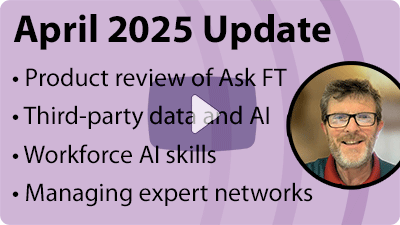 Libraries, learning and the bottom line
Libraries, learning and the bottom line
Jinfo Blog
20th March 2012
Abstract
This month I had the privilege of speaking at two library events. The first was a remarkable response to a lack of budget for employee travel. The New York Public Library system employs hundreds of librarians. Thus, it isn't a great surprise that it can't afford to send many of them to conferences and educational events.
Item
This month I had the privilege of speaking at two library events. The first was a remarkable response to a lack of budget for employee travel. The New York Public Library system employs hundreds of librarians. Thus, it isn't a great surprise that it can't afford to send many of them to conferences and educational events. Yet the need to keep staff informed and up to date on information tools and strategies inspired the NYPL to seek a grant to fund its own two day training event, open to the staff at its many branches and held at the 42nd Street Library (the one with the lions on the front stairs). The theme of the NYPL training event was Engaging Communities, Promoting Learning.
The second event in which I participated was the Associated College Libraries of Central Pennsylvania's Spring Conference. In both cases the panels I was on revolved around the work I did on the book ”Dancing With Digital Natives: Staying in Step with the Generation Transforming the Way Business is Done”. The information community has taken a keen interest in how best to use technology to engage them with, and educate them about, information.
Both audiences brought a range of challenges and insights to their questions, which I always find teach me a great deal. But at the ACLCP conference, one question included a thread woven into almost every discussion about information resources: "Universities with limited funds are competing for students, so how can we use social media to attract and keep students?"
The good news from my co-panellist (and co-editor of the book), Heidi Gautschi, is that she has been quite successful using free and open source tools to teach her Social Media class at Lesley University. Unfortunately, she pointed out that the real cost for many educators is the time investment required to learn to master these tools and how they can effectively be used for engagement and instruction. As the saying goes, time is money. And money is the root of all evil.
It is no surprise that there is increased pressure placed upon workers in roles of all types to make do with less and to rely on free "good enough" resources whenever possible. During the break after one session, a library manager leaned over and quietly asked if I thought that the increasing acceptance of "good enough" information was indicative of a dumbing down of our culture. Perhaps. More likely, though, there is a cycle of cost pressure forcing us to lower our information expectations.
The education of students and library patrons about information can only lend itself to a lifelong appreciation for quality info goods and services. Exploring the budget for, education about, and value of information provides a great many insights that we can apply to the work we do. To this end, we have launched our 4th Economic Impact Survey, sponsored by J.J. Keller. I do hope you will participate in the survey. We all have a lot to learn ... from each other.
- Blog post title: Libraries, learning and the bottom line
- Link to this page
- View printable version
Vendor adoption of AI
Community session
23rd May 2024
AI prompting and AI-sourcing, US private companies, and Jinfo on YouTube
Blog posting
10th April 2024
April 2024 Update
YouTube video
10th April 2024
- AI prompting and AI-sourcing, US private companies, and Jinfo on YouTube
10th April 2024 - AI practical actions, prompting and outsourcing
6th March 2024 - GenAI and ESG wisdom of the Jinfo crowd
13th February 2024
- Jinfo Community session (TBC) (Community) 16th July 2024
- Jinfo Community session (TBC) (Community) 20th June 2024
- Vendor adoption of AI (Community) 23rd May 2024

